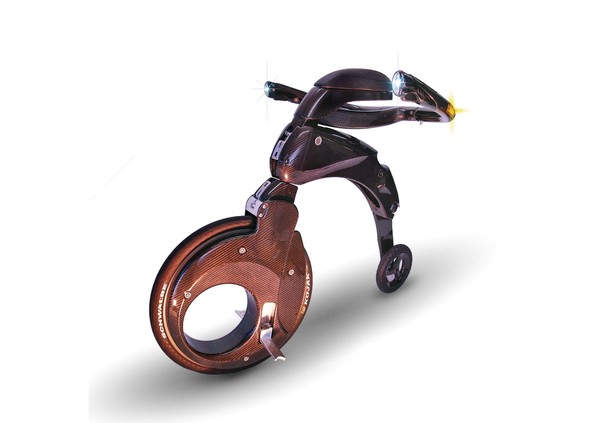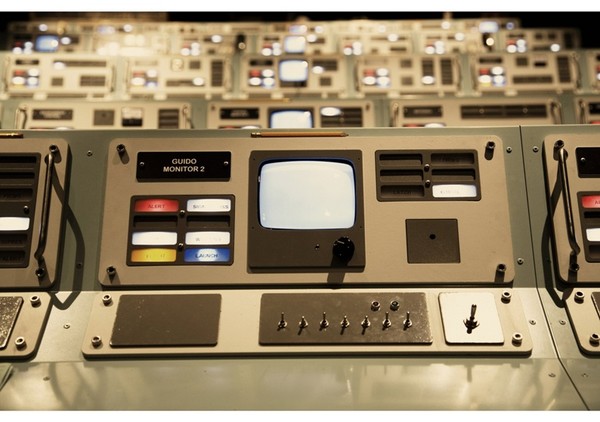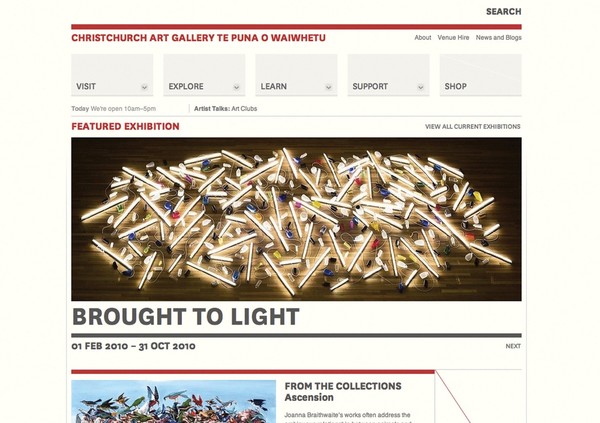From electric bikes to electric fences - NZ designers spark at 2010 Best Design Awards
Monday 4 October 2010, 11:41AM
By Dock Street Group
1,596 views
An electric bike described as the extraordinary lovechild of a Segway and a Penny Farthing; an electric fence that unfolds like a clothesline; a New York loft conversion and a stage set that resembles a 1970s space mission control room, were among the high profile winners at the 2010 Best Design Awards – New Zealand’s designs equivalent of the Oscars - which were held at Auckland’s SkyCity Convention Centre on Friday night (October 1).
Organised by the Designers Institute of New Zealand, the Best Design Awards celebrate the country’s best designs of the year across the fields of product, spatial, graphic and interactive design.
This year an impressive 603 entries were received for the awards, one of the highest number of entries since the awards were established 22 years ago.
Cathy Veninga, CEO of the Designers Institute, said the institute was delighted by the high number of entries in the awards, coming hot on the heels of the worst recession experienced by the New Zealand design industry.
She said that design, as well as being used as business tool by an increasing number of New Zealand businesses, was now percolating into more unexpected places, such as public buildings (the new Supreme Court of New Zealand was a major Gold Pin winner), art galleries, (the Christchurch Art Gallery’s new website was a major interactive prize winner), and Auckland Museum, whose simple neon sign, LATE, to promote their evening sessions won a Gold Pin in Graphic Design arts.
“It is interesting to see that institutions, such as museums, art galleries and orchestras, are using designers to create excellent brand communications to get noticed and to communicate their offerings and events.”
Veninga also praised the “outstanding” work of interactive designers and said the Institute expected interactive to be one of the key growth sectors of New Zealand design.
“Technology is developing everyday, and companies know that they have to establish a strong online presence in order to reach customers. The exponential growth of the internet, rapidly developing technologies and the importance of having a strong representation online, presents huge opportunities for the interactive design community in New Zealand.”
The year’s major design winners included Christchurch based YikeBike Ltd which won the Purple Pin (Supreme) award for product design. Dubbed by TIME magazine as one of the best designs of 2009, the ultra light carbon fibre electric YikeBike folds up into a shoulder bag in under 20 seconds. The brainchild of Christchurch serial entrepreneur, Grant Ryan, the YikeBike is currently in production and orders can be secured online.
The product judges, led by Professor Tony Parker, Head of Massey University’s Institute of Design for Industry and the Environment, said, “This radical piece of design has attracted a great deal of global attention, and no wonder. It takes typical urban commuting solutions, and turns them inside out. This contemporary penny-farthing is a game-changing idea and one where every component and detail has been designed from a single-minded perspective.”
The Purple Pin for spatial design went to Apollo 13: Mission Control, a stage set that takes interactive theatre to a new level by inviting the audience to participate in the script. Designed by actor Kip Chapman and Auckland designer Brad Knewstubb, the set resembles a 1970s mission control room at Cape Canaveral. The audience sits at around 100 consoles and obeys commands from Mission Control, the actors. The set is modular and can be quickly packed up and then reassembled. The play has already been staged in New Zealand and at venues in Australia. One Russian woman in Sydney found the production and set to be so realistic that she started to pray in Russian during the proceedings.
The spatial judges, led by convenor Andrew Tu’inukuafe, said: “The finely calibrated construction of this dynamic, interactive set design makes the audience an integral part of the performance. This project has undoubtedly created a compelling and memorable theatre experience, and marks a new direction in performance design.”
In the graphics discipline, Auckland based Studio Alexander scooped the coveted Purple Pin for an eye-catching pop-up site safety installation for client Fletcher Construction.
As part of the three-dimensional installation, Studio Alexander created a series of designs which were installed onto the sides of portable containers and dropped into construction sites before workers arrived for the day.
Designs included evocative and larger than life portraits of injured workers that focused on the emotional trauma and impact that a serious workplace injury has on family members; light-boxes that showcased x-rays of real life worksite accident victims, and a functional “Check yourself, before you wreck yourself” reflective installation, that used a mirror and checklist to force workers to check their safety gear reflection as they entered the worksite.
The graphic judges, led by convener Fraser Gardyne, praised Studio Alexander’s award-winning entry, saying the designs for what they described as an important yet ignored subject were, “special in their thinking and execution.”
“With the graphics spilling onto the ground, big and in your face, the designs were involving but never preachy. They put you into somebody else’s shoes to remind you how important the safety messages and your responsibilities are.”
The Purple Pin for interactive design went to young Christchurch website design company, Sons & Co for their website design for Christchurch Art Gallery Te Puna O Waiwhetu.
Described as “an incredibly large and complex” project to put together, the judges were overwhelmingly impressed with the company’s response to what they described as an imposing challenge – the presentation of 5700 artworks, 500 multimedia files and 900 archived exhibitions on the one site.
They said that the site charted an “uncommon intersection between craft and industrial-grade information architecture.”
“Presenting that much information onto one site, organising it in a way that is not overwhelming and making it look great at the same time is no mean feat. Sons & Co. has created a website that defies the norms of a typical ‘database driven website’. It is well considered, tailored and beautifully crafted.”
Two special Black Pin awards were given out during the night. The first, the John Britten Black Pin award for an individual who has made a major contribution to design nationally and internationally, went to Dean Poole, founder and creative director of Ponsonby based design company, Alt Group.
Dean Poole has played a formative role in the Design in Business awards run by the Designers Institute. Poole was appointed a Fellow of the Designers’ Institute in August this year.
Alt Group, who have won over 31 international awards this year alone, were major winners at this year’s awards, walking away with an impressive 21 prizes, which included seven Gold Pins, seven Silvers and seven Bronzes.
The Black Pin for Outstanding Achievement was awarded to Auckland architect, Tim Hooson, director of interior architecture at Jasmax. Hooson has been involved in the interior architecture of some of New Zealand’s most distinctive commercial buildings, including Vodafone in Auckland’s Viaduct, the NZI Building in Fanshawe Street, Auckland and BNZ Harbour Quays in Wellington. Tim is a great exponent of the importance of workplace architecture to retain happy and productive staff and has always strongly promoted the importance of interior architecture, as well as exterior architecture.
Other high profile winners at the 2010 Best Design Awards include:
- The SmartFence, A portable electric fence that unrolls like a clothesline. Gallagher’s unique and revolutionary SmartFence, can be quickly erected and dissembled by people with no prior fencing experience and was awarded a coveted Gold Pin in product design. The fence was initially developed for Swiss farmers who keep their livestock indoors for winter, but take them into the mountains to graze in summer. The judges described SmartFence as a “classic piece of Kiwi ingenuity” which presented a commercial opportunity to a “successful design-led New Zealand business.”
- Merlin, by Tauranga based Trimax Mowing Systems. A great advance on a Kiwi classic. A stylish and innovative tri-deck rotary mower. Merlin is designed for the global golf market: there are some 34,000 golf courses around the world. It can rove over the rough and also clip the fairways as sharp as a scalpel can. Launched at Royal Windsor racecourse in the UK in early September, Merlin is already performing beyond expectations in the local and international marketplace. (Silver award, product category).
- Tribeca Loft – This gorgeous New York loft, designed by leading Auckland architects, Fearon Hay, has minimal partitions to maximize an airy feeling of openness. (Gold Pin, residential, spatial).
- I love Mum Post-it Installation ‘I Love Mum’- Passersby were encouraged to write notes on post-it notes to their mothers for Mothers’ Day in this installation at Queen St Whitcoulls. Design studio: Apropos. (Gold Pin, in environmental graphics, graphics category)
- Air New Zealand’s Space and Sky Couch seats. Both these seats for Air New Zealand’s 777-300 aircraft won Gold Pins in the furniture section, for Designworks studio. The product judges said of Sky Couch: “The extent of exploration required to get the design commercialised has led to a ground breaking result.”
- The Cupcake Pavilion – OH.NO.SUMO is a group of young architects who designed a cupcake pavilion made out of cardboard at Britomart during Architecture Week. The pavilion, which sold 1000 cupcakes in aid of Starship Hospital, won a Gold Pin in spatial, exhibition, installation and temporary structures.
- Supreme Court of New Zealand - Warren & Mahoney’s designs for the “Court of last resort” impressed the judges, who awarded the building a Gold Pin in spatial design. The judges said the building’s designers successfully “combined the architectural and legal traditions of the past with a modern sense of dynamism”. The most prominent feature of the building - its intricately detailed interwoven dome interior, which is comprised of more than 2000 panels of silver beech timber - won special praise from the judges. “The intricately woven mesh, which forms a soaring dome, makes one almost feel inspired to take off, divine in its opening to the heaven.”
- The Blunt Umbrella – Released earlier this year, and selling well in Japan, the Blunt Umbrella has been described as one of the best advances in umbrellas since collapsible umbrellas were released in 1928. The brolly has a radical new shape with rounded end ribs and sharp spikes eliminated so users don’t poke passersby in their eyes, and is so sturdy it can withstand gale force winds of up to 115 km an hour. Great for Wellington civil servants (Silver, Product category).
- Storm of Enquiry –won a Gold Pin in Applications for Neon Playground. This is an interactive piece that was exhibited as part of the exhibition Design in Crisis in Auckland in September, 2009. Viewers were encouraged to participate in the work by sending SMS which then appeared in a cloud and rained down upon them. They could shelter from the 'rain' by carrying an umbrella.
Other standout winners included Methven’s Kiri Ultra Low Flow Shower which won Gold in Sustainable Product; Alt Group’s Be Project - Thinking outside the chair, a book describing the design journey of Formway’s Be Chair (Gold in Corporate Communication, graphics); and A Taste of Yellow Chocolate, packaging for Yellow Pages’ chocolate bar that tastes like yellow, which won Silver in Packaging for Auckland design company, Seven.
The Best Design Awards were established in 1988 and have been held annually since 1996. All winners can be viewed online at www.bestawards.co.nz



